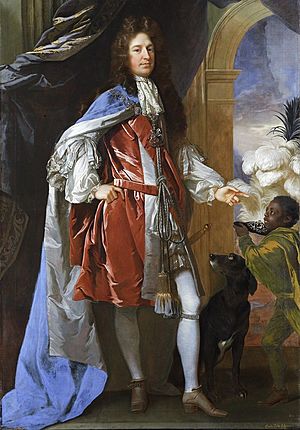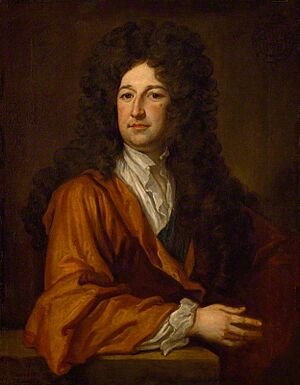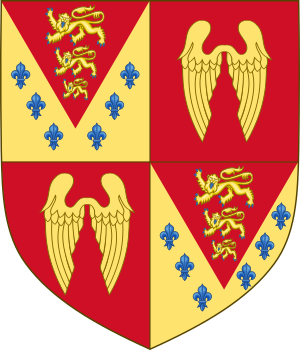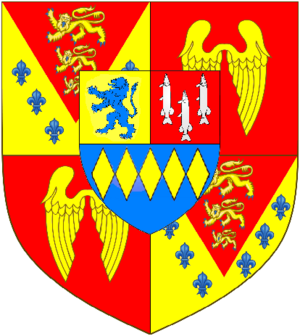Charles Seymour, 6th Duke of Somerset facts for kids
Quick facts for kids
The Duke of Somerset
|
|
|---|---|

Portrait by John Closterman, c. 1690–1692
|
|
| Lord President of the Council | |
| In office 29 January – 13 July 1702 |
|
| Monarch | William III Anne |
| Preceded by | Thomas Herbert, 8th Earl of Pembroke |
| Succeeded by | Thomas Herbert, 8th Earl of Pembroke |
| Personal details | |
| Born | 13 August 1662 Wiltshire, England |
| Died | 2 December 1748 (aged 86) Petworth, Great Britain |
| Resting place | the Seymour Chapel of Salisbury Cathedral |
| Spouses | Lady Elizabeth Percy Lady Charlotte Finch |
| Children | 9, including Algernon |
| Parents | Charles Seymour, 2nd Baron Seymour of Trowbridge (father) Elizabeth Alington (mother) |


Charles Seymour, 6th Duke of Somerset (born August 13, 1662 – died December 2, 1748) was an important English nobleman and courtier. People often called him "The Proud Duke" because he was very proud of his family and position. He was known for being very handsome and loved to be part of royal ceremonies. He rebuilt Petworth House in Sussex, making it a grand palace that you can still see today.
Contents
Who Was Charles Seymour?
Charles Seymour was born in 1662 in Wiltshire, England. His father was Charles Seymour, 2nd Baron Seymour of Trowbridge. His family was connected to royalty through Edward Seymour, 1st Duke of Somerset, who was the brother of Queen Jane Seymour and uncle to King Edward VI.
Early Life and Education
Charles went to Harrow School and then to Trinity College, Cambridge. A portrait of him still hangs at Trinity College.
Becoming the Duke of Somerset
In 1675, Charles's older brother, Francis, became the 5th Duke of Somerset. Sadly, just three years later, in 1678, Francis was murdered in Italy when he was only 20 years old. Since Francis had no children, 16-year-old Charles became the 6th Duke of Somerset.
His Important Marriage
In 1682, when he was 20, Charles married a very wealthy 15-year-old girl named Lady Elizabeth Percy. She was the only child of Joceline Percy, 11th Earl of Northumberland. This marriage brought Charles huge estates and castles, including:
- Alnwick Castle
- Petworth House
- Syon House
- Many other valuable lands
It was agreed that Charles and his children would take the Percy name to keep that noble family's name alive. However, Elizabeth later decided not to change her name. Much later, in 1749, their granddaughter and her husband did take the Percy name to honor the family's history.
Rebuilding Petworth House
Between 1688 and 1696, the Duke completely rebuilt Petworth House. He made it into a magnificent palace. Paintings from that time show it looked like a French chateau, with a central dome and statues on the roof. Today, the roof is flatter, possibly due to a fire in 1714. He kept the old medieval chapel, which has a large window showing the coats of arms of the Percy family.
His Life in Politics and at Court
Charles Seymour was active in royal politics.
- In 1683, he got a job in King Charles II's royal household.
- In 1685, he became a Colonel in King James II's army.
- However, he lost favor with King James II in 1687. He refused to escort a new representative from the Pope, which King James II didn't like.
When William of Orange became King William III in 1689 (during the Glorious Revolution), Charles supported him. He became good friends with Princess Anne. When Anne became Queen in 1702, she appointed him Master of the Horse, a very important role in the royal household. He held this job until 1712.
His wife, the Duchess of Somerset, also became a close friend and advisor to Queen Anne. She even replaced the Duchess of Marlborough as the Queen's Mistress of the Robes in 1711.
When Queen Anne was very ill, the Duke of Somerset played a key role. He and other noblemen made sure that the next in line for the throne would be from the House of Hanover, which was important for Britain's future.
After King George I came to the throne in 1714, the Duke kept his job as Master of the Horse for a year. Then he retired from public life in 1715.
Helping Children in Need
In 1739, the Duke became a founding governor of the Foundling Hospital in London. This was the country's first home for abandoned children. His second wife, Charlotte Finch, was the first person to sign the petition to King George II to create this important hospital.
His Family Life
The Duke of Somerset was married twice.
First Marriage
In 1682, he married Lady Elizabeth Percy. She was already a widow twice over. As Duchess of Somerset, she held important positions at Queen Anne's court.
After Elizabeth died in 1722, the Duke showed romantic interest in Sarah Churchill, Duchess of Marlborough. He sent her many letters, but she remained devoted to her late husband.
With Lady Elizabeth Percy, he had one son who survived to adulthood and several daughters:
- Algernon Seymour, 7th Duke of Somerset (1684–1749). He inherited the dukedom. His daughter, Lady Elizabeth Seymour, later inherited half of the large Percy estates, including Alnwick Castle and Syon House. Her husband, Sir Hugh Smithson, 4th Baronet, later took the Percy name and became the Duke of Northumberland.
- Lady Elizabeth Seymour (1685–1734).
- Lady Catherine Seymour (1693–1731). Her son, Charles Wyndham, 2nd Earl of Egremont, inherited the other half of the Percy estates, including Petworth House.
- Lady Anne Seymour (1709–1722).
Second Marriage
In 1725, at age 63, he married Lady Charlotte Finch (1693–1773). She was much younger than him. He was known for being quite strict with her. He once famously told her, after she gently tapped him with her fan, "Madam, my first wife was a Percy and she never took such a liberty."
With Lady Charlotte Finch, he had two more daughters:
- Lady Frances Seymour (1728–1761).
- Lady Charlotte Seymour (1730–1805).
Death and Burial
Charles Seymour, 6th Duke of Somerset, died at Petworth on December 2, 1748. He was buried in the Seymour Chapel of Salisbury Cathedral in Wiltshire.
Passing on the Titles and Estates
The Duke's only surviving son, Algernon, had a grandson who sadly died young without marrying. This meant that the main line of the Seymour family was likely to end with Algernon.
The 6th Duke wanted to make sure his family's important estates and titles were passed on carefully. He worked with King George II and his son, Algernon, to decide how the vast Percy estates would be divided.
- Sir Hugh Smithson, 4th Baronet (who married Algernon's daughter) received Alnwick Castle and Syon House.
- Sir Charles Wyndham, 4th Baronet (who was the 6th Duke's grandson through his daughter Catherine) received Petworth House and Egremont Castle.
To honor these important families, King George II created new titles in 1749 for Algernon, the 7th Duke. These titles were set up so that when Algernon died without a male heir, they would pass to Smithson and Wyndham, ensuring the continuation of these noble lines.
Family Coat of Arms
The Seymour family's coat of arms is very special. It includes:
- Three golden lions on a red background with blue fleurs-de-lys (a special design given to the first Duke of Somerset by King Edward VI). These symbols connect the family to the royal arms of England and France.
- Two golden wings on a red background, which is the traditional Seymour family symbol.
The 6th Duke also added a smaller shield on top of his main arms, showing the symbols of the Percy family. This was to honor his wife's important family.
See also



